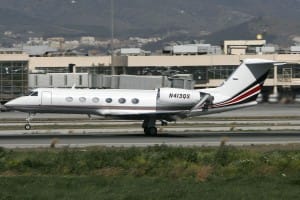Jet Cards… What and Why?
If you spend a few minutes shopping for anything related to private jets, whether it be a charter flight or an entire aircraft, you’ll probably come across some sort of “jet card” program. If you’re even slightly considering purchasing a jet card, make sure to continue reading this article.
Simply put, a jet card is an account where a buyer locks him/herself into a pre-set number of flight hours to be flown during a pre-set period of time, on a pre-set type of aircraft, such as a Cessna Citation X, for a pre-set price; that much is pretty standard. The aircraft and flight infrastructures behind the various cards differ vastly however, and such cards only make financial sense to very specific types of fliers.
The original jet cards were conceived on the notion that they would lower the entry barrier into fractional programs such as NetJets and FlexJet, offering travelers the opportunities to fly fractional aircraft for a mere 25 hour annual commitment as opposed to a 100+ annual commitment and asset purchase. Jet cards through fractional aircraft providers offer their cardholders the consistency and predictability often assimilated with a fractional carrier; late model planes, planes with like paint schemes and cabin configurations, and consistent customer service.
More recently, the market welcomed jet cards offered by charter brokerage companies. Unlike the cards offered by fractional providers, cards offered by charter companies offer less flight experience consistency, though can match (or exceed, based on the outfit) the customer consistency on the ground of a fractional carrier. Flights by jet cards offered by charter brokerage companies are fulfilled by the national network of part 135 charter planes, which are individually owned aircraft placed on the charter market to defray operating costs for their owners. Cards offered by charter brokers tend to be mildly less expensive than those offered by the fractional carriers primarily because charter brokers can fulfill most of the flights for significantly less than the cost of fractional carrier flights.
It is this writer’s belief that jet cards in general should be avoided by most (but not all). To support my opinion.
1. The cost of one hour on a jet card is generally about the cost of two hours of a jet charter (though ferry hours may be required in a charter).
2. The cost of a jet card flight will be consistent for a given route, however the charter cost for the same flight will be less in most scenarios despite jet card marketing propaganda, and can be significantly less in many cases thanks to one-ways, empty legs, and floating aircraft.
Furthermore, it is this writer’s belief that jet cards offered by charter brokerage companies should be avoided even moreso. Charter brokerage companies fulfill their card member flights the same way they fulfill one-off charter flights. If a jet card member were to request a flight from New York to Los Angeles on their Gulfstream GIV card for example, the pre-set rate might fall in the $60,000.00 + tax range, similar to the cost of the fractional jet card. The charter brokerage company will likely turn to the wholesale market and cover said flight for $35,000.00 + tax if availability is good, leaving them with a “winning flight.” As the owner of The Early Air Way, a charter brokerage firm, I’ve designed our system to price flights based off of current wholesale market inventory, meaning that your price would be about $35,000.00 + tax for the same flight. It is true that we wouldn’t guarantee that $35,000.00 + tax rate on every flight whereas a cardholder elsewhere would be guaranteed the $60,000.00 + tax rate, however we seldom have to charge anyone the $60,000.00 + tax rate ever, even when availability isn’t optimal.
Jet cards make sense for charter fliers sometimes, however. On short (generally under one hour in duration) one-way or overnight flights, between two small towns, or on a heavy cabin aircraft such as a GIV, charters can be loaded with extra costs whereas your jet card program will still pass along your preset hourly rate. These are the few flights that can often be less expensive with a jet card than with a straight charter and would be a “losing flight” for the card provider. It is the general belief that the significantly larger profit margin on most flights through a jet card system will far outweigh the potential losses incurred by the provider on the rare “losing flights” mentioned above, offering an overall increased operating margin to the provider. Unless you fly a Gulfstream on one-way trips between two very small towns less than 500 miles apart from one another regularly however, you will likely be overspending by a significant margin with a jet card.
If you must purchase a jet card however, be sure to select the program with the most stability; after all, the provider will be holding a significant amount of your cash. Be sure to vet out charter brokerage companies with fewer than 5 years of history. If your broker’s jet card flight ratio of “winning flights” to “losing flights” is bad for a short period of time, the company can too easily go bust, disappearing along with your deposit. I will argue that the only jet cards worthwhile are those offered by large fractional providers, even if they cost more than those offered by brokerage firms, ONLY if you are one to regularly fly the rare “losing flights” previously mentioned. You can always hedge your card, making sure you simply charter a flight instead of booking a “winning flight” through your card provider.
Jet Cards aren’t for most, but they will benefit a select few. For most, on-demand charter is the way to go.

